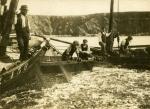On June 6, 1912, after five days of violent earthquakes on the Alaska Peninsula, one of the most gigantic eruptions of the 20th century occurred from a previously unknown geological formation called Novarupta, Latin for “new eruption”. For 60 hours the eruption sent ash and pumice into the sky as high as 30 km and darkened the sky over most of the Northern Hemisphere. As the ejected materials rained down back into the valley it smothered a 100-square km area with ash and pyroclastic flows up to 200 meters deep. Ash fell two feet deep in the neighbouring Kodiak Island 185 km away, and fumes produced acid rains 600 km away, tarnishing brass as far away as California and Colorado. The high-altitude haze robbed the northern temperate zone of an estimated 10 percent of the Sun’s heat during the summer of 1912.
Four years later when National Geographic Society sent Robert F. Griggs for a cover story, he found the valley engulfed in superheated steam escaping from thousands of fissures and cracks. The incredible sight prompted him to name the once vibrant valley “the Valley of Ten Thousand Smokes.”

Photo credit: Robert F. Griggs / National Geographic Society. 1916
Read more »© Amusing Planet, 2015.









Comments